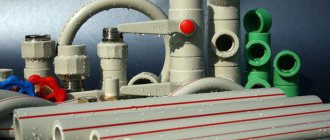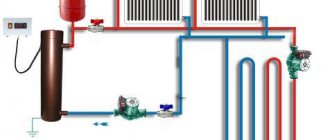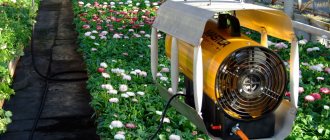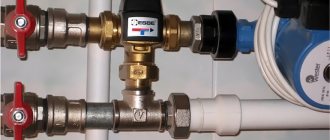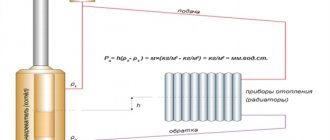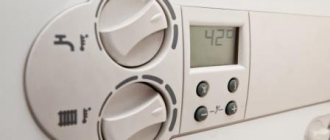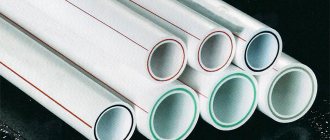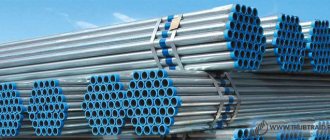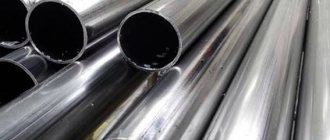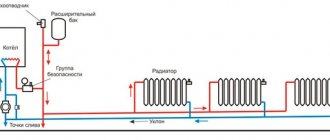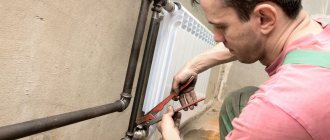Is it possible to use plastic pipes for heating?
Plastic quickly loses technical characteristics when exposed to high temperatures. Therefore, when choosing plastic pipes for heating, you need to select products that meet a number of requirements:
- The plastic must be able to withstand the temperature of the coolant. The maximum temperature is 95 degrees. At this temperature, the pipes should not be deformed.
- The pipes must withstand high pressure so that water hammer occurring in the system cannot destroy the pipeline.
- Minimum coefficient of thermal expansion. Otherwise, individual elements of the pipeline will sag when heated. When temperatures drop, internal stresses may occur, which negatively affect the strength of the tubes.
- The pipes must be straight from the inside. If this requirement is not taken into account, plaque will accumulate on the inner walls, which will lead to blockages.
- Pipeline elements should not be destroyed when exposed to various chemicals that may be contained in tap water.
- The individual elements from which the heating circuit is assembled must be durable in order to function for a long time without breakdowns.
- The pipes must have a high level of sound insulation so that the flow of water cannot be heard in the rooms.
Plastic pipes meet all the necessary requirements, but they have one serious drawback - a high coefficient of thermal expansion. Because of this, long tubes can sag when heated. To prevent this, you need to install special compensators. They minimize the risk of tube deformation during thermal expansion and increase the strength of pipeline joints.
Pipes for high temperature heating systems
High-temperature systems include heating systems with solid fuel boilers without any adjustment. I will also include gravity and open heating systems as such systems.
In such systems, the boiler is often loaded with coal and heated. At the same time, there are no monitoring systems for the operation of the system, except for the expansion tank on the roof. And it often happens that the system becomes airy and the coolant circulation stops.
As a result, the system overheats and boils. That is why only steel or copper pipes are suitable for such heating systems.
What pipes should be used for heating a private home if there is a risk of overheating or boiling in your heating system? It is necessary to assemble such a heating system using steel or copper pipes.
Characteristics
Technical characteristics determine the scope of application of the products. The manufacturer indicates them on the packaging of the pipes or on the plastic surfaces themselves. Options:
- the material from which the parts are made;
- diameter of plastic pipes;
- maximum coolant temperature;
- the maximum pressure that the pipe can withstand;
- sizes of plastic pipes for heating.
To indicate characteristics, a labeling system for products made from different types of plastic was developed.
Pipes for hot coolant
Cost and where to buy
CPVC structures, as we have already said, are characterized by a higher cost than their PVC counterparts. On average, one meter of pipe made of the material in question can cost from 1.5 to 5 US dollars. The price is significantly influenced by technical characteristics, cross-sectional indicator and product manufacturer.
It is advisable to purchase the products in question exclusively from trusted suppliers. It is best to make purchases directly from the manufacturer or an authorized dealer. In this case, be sure to check the availability of certificates of conformity for products and warranty periods. This will allow you to avoid buying low-quality fakes, of which there are quite a lot on the market now.
Watch the video:
Marking
There are several types of plastic used to make pipelines:
- PVC pipes;
- polypropylene products;
- polyethylene parts.
A separate group includes tubes, during the manufacture of which a reinforcing layer of aluminum foil or fiberglass is placed between layers of plastic.
The marking varies depending on the type of polymer. There is no point in describing the designations on PVC, since this material is not used for the manufacture of water supply and heating pipelines. This type of polymer releases harmful substances when heated and has low performance characteristics.
Polyethylene marking:
- PE 32 is a type of polyethylene with the lowest density. It is rarely used for making pipes.
- PE 63 - used for assembling non-pressure systems. This could be sewer drains, an outdoor shower. This type of polyethylene cannot withstand high pressure and is destroyed by water hammer.
- PE 80 is a type of polyethylene with a high strength index. Used for assembling cold water supply systems. If the pipeline is laid outside buildings, additional insulation must be used.
- PE 100 - pipes made from this type of polyethylene have the highest strength index. They are used for the manufacture of industrial pipelines, hot and cold water supply systems, heating circuits.
The marking of polyethylene tubes contains the abbreviation SDR, followed by numbers. The lower this indicator, the stronger the product.
Marking of polypropylene tubes:
- PN10. Products with this designation can withstand pressure up to 1 MPa. The permissible liquid temperature is 45 degrees Celsius. Due to their low strength and heat resistance, such tubes are used for assembling sewage drains and cold water supply pipelines.
- PN16. The maximum permissible pressure level is 1.5 MPa. The coolant temperature should not exceed 60 degrees. Popular for the manufacture of cold water supply systems. Rarely used for assembling hot water circuits.
- PN20. Tubes made of this type of polypropylene can withstand pressure up to 2 MPa. The maximum permissible coolant temperature is 80 degrees. Used for assembling hot and cold water supply systems, heating circuits.
- PN25 is the most durable type of polypropylene. This material can withstand pressure up to 2.5 MPa. The coolant temperature can rise to 95 degrees. Withstands temperature surges - up to 110 degrees.
Marking of multilayer products:
- PPR - the outer layer of the tubes is covered with polypropylene;
- AL - has a reinforcing layer of aluminum foil;
- PP-RCT is a designation for modified polypropylene, which has increased thermostatic properties.
If there is a layer of fiberglass inside the pipe, the marking will contain the letters FG, FR.
Heating pipes made of polypropylene
Which PPR pipes are suitable for heating
Polypropylene pipes began to be used for heating systems relatively recently. Before this, their place was taken by solid steel pipes. Such structures were connected by welding, were durable, but difficult to install and expensive to manufacture.
Polypropylene pipes have gone through a number of important metamorphoses over their short history. Polypropylene itself does not have the heat resistance that the companies developing it expected. That is why the first heat-conducting systems with such pipes quickly fell into disrepair, and they began to be skeptical about the material itself.
At the moment, polypropylene pipes have been significantly improved. There are various models that are used to supply cold and hot water, heat supply and sewage disposal. When carrying out repairs, it is important to choose pipes that are designed for specific purposes, otherwise the structure will not be suitable for use.
It is important! At the moment, there are many companies producing and selling pipes for heating systems. It is advisable to buy pipes along with all components from official suppliers in specialized stores, since there are many low-quality fakes.
Types of PPR pipes
Polypropylene pipes are used in various areas, but not all are suitable for heating. In pursuit of cheap material, you may buy the wrong type of pipe that could withstand hot water under pressure. It is important to be able to distinguish one type of pipe from another.
The classification of polypropylene pipes is as follows:
- RR-N. This is the first generation of polypropylene pipes. This model has all the properties of the base material. PP-N are hermetically sealed and resistant to high pressure, in addition, they do not enter into chemical reactions. However, melting of such a pipe can begin already at a temperature of 50 ͒ C. Such pipes are used in cold water supply systems, ventilation and for industrial purposes;
- RR-V. During the production of this type, the formula of the material was slightly changed. The pipes turned out to be stronger and more durable, but they still could not withstand temperature fluctuations. Such pipes have the advantages of previous generation and, in addition, better withstand the effects of hot temperatures. However, they are unsuitable for heating systems and even hot water supply. Such pipes are often used in sewer construction;
- PP-R. In the production of these pipes, in addition to polypropylene, ethylene is used. This allows them to withstand high temperature loads. In addition, such pipes, as a rule, are reinforced, which allows them to withstand temperatures of more than 100 ͒ C. Reinforced PP-R pipes are the most suitable option for a heating system.
We recommend that you read: Replacing old pipes with polypropylene on your own
Reinforced pipes
Reinforcement is the process of covering a pipe with a material that, in terms of strength or other properties, is superior to the main material of the structure. In the case of polypropylene pipes, reinforcement means coating the pipe with metal, which retains heat and prevents pipe deformation under the influence of high temperatures. Reinforcement can be of two types:
- Aluminum. In this case, the surface of the pipe is covered with aluminum foil. Sometimes such foil is embedded between layers of polypropylene. Aluminum does not allow PPR to expand and change its shape. However, such pipes have one significant drawback - they can delaminate. Delamination occurs if the pipe is made of low-quality materials or is improperly joined to another pipe;
- Fiberglass. This coating is woven between layers of polypropylene. This makes the delamination process impossible. Such pipes are integral and do not deteriorate due to improper installation or operation. The service life of PPR with fiberglass coating is longer, however, such pipes are more expensive.
Technical characteristics of heating pipes
The characteristics of pipes are based on resistance to various factors that act during operation. When choosing pipes for a heating system, you need to pay attention to the following parameters:
- High pressure resistance. Reinforced polypropylene pipes can withstand a system pressure of 6 atm. at a temperature of 70 ͒C. The higher the temperature, the less resistance to pressure. In the heating system, hot water is not supplied at maximum pressure;
- Temperature resistance. Polypropylene pipes with reinforcement begin to melt at a temperature of 120 ͒ C. In the heating network, the temperature rarely exceeds 70 - 75 ͒ C, which creates a reserve of heat capacity in the system. PPR can withstand frost worse than heat;
- Non-corrosive. The main disadvantage of metal pipes is the possibility of reacting with water. Sooner or later, such pipes rust and cease to be airtight. Polypropylene does not corrode when exposed to water. Moreover, it does not react with salts and other impurities that may be found in the system;
- Durability. Manufacturers promise a pipe service life of half a century, but do not give guarantees. In fact, the durability of the structure depends on the type of reinforcement, the correct installation, the temperature inside and outside the pipes, and the pressure in them. If you follow all the recommendations, you can forget about repairs for several decades.
It is important! Polypropylene pipes can be installed outdoors only for residents of the southern regions. When the temperature outside the system is less than -15 ͒ C, polypropylene becomes brittle and pipes may break. Such designs are only suitable for pipelines located indoors.
Selection of heating pipes
For heat pipes, it is better to give preference to polypropylene with fiberglass reinforcement. However, pipes made of this material are also different. They vary in diameter and ability to withstand a certain pressure in the system. The following categories of pipes are distinguished by diameter:
- Less than 1.6 cm. Such pipes are suitable exclusively for underfloor heating systems. This diameter should be sufficient if the pipes are installed correctly;
- 2.0 - 2.5 cm. The most popular diameter when installing heating in a house or apartment. For the riser that goes into the apartment, a diameter of 25 mm is required, and pipes of 20 mm are installed in the rooms;
- 2.5 - 3.2 cm. This category is used in multi-storey buildings with centralized heating;
- More than 20 cm. Pipes of this diameter are needed for large organizations. For example, hospitals with many departments, wards and offices.
We recommend that you read: How does a single-pipe heating system work in a private house?
It is not difficult to determine the pressure that the pipes can withstand. Just look at the PN marking and the number after it. Thus, PN 10 can withstand a pressure of 10 atmospheres at a temperature of 45 ͒ C, PN 16 - 16 atm. at a temperature of 60 ͒ C, PN 20 - pressure 20 atm. at a temperature of 80 ͒ C, PN 25 - 25 atm. at a temperature of 100 or more ͒C. For the heating system, you must choose at least PN 16, preferably PN 25.
Thus, the best option for heating pipes is fiberglass-coated polypropylene pipes with a diameter of 2 - 2.5 cm and marked PN 25.
Varieties
You can find different types of plastic pipes that are used to make pipelines. Types of pipes used for assembling heating circuits:
- Polypropylene. A material that is most often used in the manufacture of pipelines for heating, cold and hot water supply. This is due to the many advantages of this material and low price.
- Cross-linked polyethylene. Tubes made of this material are more expensive than polypropylene. Suitable for installation indoors and outdoors. Withstands temperatures from -50 to 100 degrees. Destroyed by prolonged exposure to ultraviolet rays. Because of this, they need to be mounted in protective housings.
- Metal-plastic products. Such tubes are often used in the manufacture of pipelines. The parts consist of several layers - an outer and an inner layer of polyethylene. Between them there is aluminum foil.
The choice of material depends on the operating conditions and required technical characteristics.
XLPE pipes for heating
The next type of pipes are pipes for heating a private house made of cross-linked polyethylene. Today, these pipes have practically replaced metal-plastic pipes.
The characteristics of cross-linked polyethylene pipes are similar to metal-plastic pipes. But in some respects it’s even better.
For example, metal-plastic pipes are multilayer pipes and there is a potential threat of layer delamination. But pipes made of cross-linked polyethylene are monolithic. Due to this, they seem to be more reliable.
Also, pipes made of cross-linked polyethylene today are cheaper than metal-plastic ones. But if you take fittings for pipes made of cross-linked polyethylene, then their cost is the same as press fittings if you take brass analogues.
Of course, today there are both plastic fittings. But if we take our mentality, then, of course, we love brass fittings.
I have already made several objects with pipes for heating a private house from cross-linked polyethylene with a tension sleeve. I like it. Of course the process is labor-intensive. You need to cut the pipe, put a tension sleeve on it, expand the end of the pipe with a special expander, insert a fitting, insert it together with the pipe into a special press for tension sleeves and tighten the sleeve.
The main difference between fittings for cross-linked polyethylene pipes and fittings for MP pipes is that they have an increased passage. What cannot be said about fittings for MP pipes. For MP pipes, the passage is narrowed by half.
Pipes made of cross-linked polyethylene are now actively used for installing heated floors. Since the price is good and the heat dissipation is better.
I think that soon cross-linked polyethylene pipes will completely replace MP pipes.
To summarize, I believe that cross-linked polyethylene pipes have no disadvantages, as they are gaining popularity today.
Advantages and disadvantages
Advantages:
- Plastic pipes do not collapse when exposed to moisture for a long time.
- The material is environmentally friendly. It does not emit harmful substances when heated.
- Due to low thermal conductivity, water reaches the heat exchangers without cooling.
- The average service life under normal operating conditions without overload is 50 years.
- Thanks to the high sound insulation of the material, the sound of water flowing through the pipes is not heard in the rooms.
- Plastic parts are easy to transport and assemble together without the help of others.
- Plastic does not deform when exposed to chemicals that may be contained in pipeline water.
- Plastic tubes have smooth inner walls. Thanks to this, plaque does not accumulate on them.
Flaws:
- High coefficient of linear expansion. It must be taken into account when connecting individual pipeline elements.
- Low heat resistance. Therefore, when installing a pipeline outdoors, you need to use additional insulation.
- The material ages faster when exposed to ultraviolet rays.
If pipes are mounted on vertical surfaces, more fasteners must be used to prevent individual pipeline elements from sagging.
Easy pipe installation
Installation
To make a heating system from plastic pipes, you do not need to hire builders. To do this, you need to prepare tools, materials and do the work yourself. Stages of work:
- Prepare heating pipes in a private house or apartment. They are cut to the required sizes using special scissors. The edges are cleaned of dirt, dust, and degreased.
- Connections of individual elements can be made using couplings or butt joints. To do this you need to use a special soldering machine.
- After heating the individual parts on a heated soldering iron, they are connected to each other.
All that remains is to wait for the plastic to cool and perform a test run of the pipeline.
Plastic pipes are becoming more popular every year. This is due to the technical characteristics of the material and low price. To assemble heating systems, you can use different types of polymers. When choosing a material, you need to take into account a number of requirements and features. After purchasing individual pipeline elements, you can assemble it yourself. To do this, you need to study the technology and carry out installation work.
Rating of polypropylene pipes. Which polypropylene pipes are better?
Every person, when repairing worn-out networks and new construction, asked the question: which pipes to choose for heating and water supply? We did not delve into the question in a broad sense, but tried to find out and answer the question: polypropylene pipes - which are better? We took and conducted an independent survey on social networks and with installation organizations working with polypropylene pipes. Based on survey data, polypropylene pipes turned out to be one of the most preferred materials for installing heating and water supply systems, regardless of the manufacturer. Most of the respondents spoke in favor of its ease of use, “dust-free environment,” high installation speed, reliability of welding units and, most importantly, affordability.
Approximately 63% of respondents spoke not only in support of the use of polypropylene pipes for heating and water supply, but also in favor of specific manufacturers, emphasizing their so-called positive and negative aspects. Taking the survey data, we summed them up in the so-called POLYPROPYLENE PIPES RATING, thereby clarifying the question - “Which polypropylene pipes are better?” Moreover, the opinion of both professionals and ordinary users of PP-R systems was taken into account.
Polypropylene pipes, also known as PP pipes, PPR pipes, PP-R pipes, PP-RCT pipes, etc. There are various manufacturers and brands on the Russian market. Among them: Banninger, Kontur, SPK, Akwatherm, Ekoplastik, TEBO, Valtek, FIRAT, Kalde, Jakko, BLUE OCEAN, FV-Plast, Dyzain, PRO AQUA, RVK, Heisskraft, Wefatherm and a large number of new ones that have recently appeared. All of them are in different price categories and completely different brands predominate in each region of Russia.
The surveys showed a hierarchy of producing countries in the following order:
1st Place: Germans Aquatherm, Banninger and Wefatherm. The three “green brothers” were supported by a larger number of professionals. The qualitative component of these manufacturers and the country of origin directly affects their cost. Among the disadvantages was also the inaccessibility in medium and small cities of Russia. Although some “users” made it clear that repairing water supply and heating networks for them is a responsible process, and the choice of materials is the main guarantee of the durability and trouble-free operation of the system.
2nd Place: Czechs FV-Plast and Ekoplastik. Pipes from these manufacturers have also proven themselves well among installers. The price category of these manufacturers is lower than that of the Germans, but availability is also poor. The traditional color to which Czech polypropylene pipes are tied is gray.
3rd Place: Turks TEBO, Pilsa, FIRAT, Kalde, SPK. This segment of pipes is most common in Russian cities. The affordability and availability of Turkish pipes in almost every city makes these manufacturers the most popular in the “budget segment”.
4 Place: polypropylene pipes made in China and Russia. This segment of the minimum price category can be found in hypermarkets and plumbing stores in almost any city in Russia. They are also widely used by developers for tying utility networks to apartment buildings due to their low cost. If we talk about the “Budget” series, then Russian and Chinese polypropylene pipes are leaders in it.
Installation organizations working with polypropylene pipes from different manufacturers have identified many different disadvantages. Such as: turning the threaded insert of a fitting, the difference in wall thickness at the pipe cut, swelling and blistering of reinforced pipes, a pungent odor during welding, “snotty” during welding, the release of blackish smoke when heated, some pipes burst when freezing, some even showed signs of cracking when they were reinforced. linear expansion of an ordinary pipe and twisted into a “wave” when starting heating systems and much more.
Each installer selected polypropylene pipes from the budget series and the premium series. They justify this choice by the fact that the client is different: some need cheaper, some need the highest quality, albeit expensive.
When interviewing professionals, they unanimously assured us that quality does not come cheap. Polypropylene pipes are no exception.
Rating of polypropylene pipes
Rating of polypropylene pipes based on customer surveys, on the Internet and directly through personal contact
